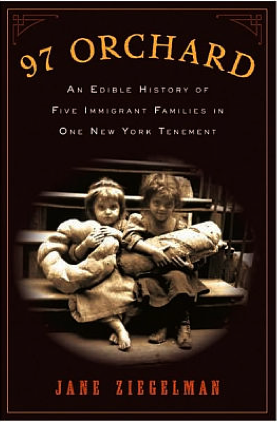
Arm Chair Critic
Patricia B. Bertschy Reviews:
97 Orchard: An Edible History of Five Immigrant Families in One New York Tenement
by Jane Ziegelman
Smithsonian Books, Harper Collins Publisher, 2010
97 Orchard is a story of immigration, food, and life in the tenements of New York City at the turn of the 20th Century. Jane Ziegelman's book reads like a novel as she traces the lives of five families – German, Irish, Prussian Jew, Russian and Italian, who shared the address of 97 Orchard between 1880 and 1920.
Early tenements, short for "tenant houses," were an answer to the New York's first housing shortage. Investors like John Jacob Astor purchased old houses, stables, even workshops, and converted them to multi-family units for poor, immigrant families. But when Lucas Glockner, a German tailor and an immigrant himself, completed the building at 97 Orchard, it was no ordinary tenement.
He infused the five-story house with style: a stone arch framed the doorway, curved lintels and a stone sill bordered the windows and marble panels lined the hallways. Proud of his work, Mr. Glockner moved his own family there in 1870.
Despite the ornamentation, the tenement was still a moneymaking proposition, and Glockner cut costs by providing no plumbing or interior bathrooms in the building. Women and children carried large tubs of water for washing clothes, cooking and bathing up the narrow, unheated flights of stairs to their homes. One of the many archival photographs depicting life in the tenements shows a somber-looking woman in the kitchen/living room of her apartment, surrounded by her five equally solemn-looking children, and the tubs of water on wash day. It is a moving scene.
Life was hard. Jobs open to immigrants were menial and money was scarce. Husbands often deserted their families, leaving children, especially girls, to labor as seamstresses and flower makers or at one of the home occupations – shelling nuts for candy factories, washing or sewing.
Occupations followed nationalities: Germans were tailors; Jews, butchers; Irish, the newest wave of immigrants, were given the most undesirable jobs as washing women and maids. But women found comfort in preparing the foods of their homeland. Street markets flourished and women shopped daily, sometimes more than once a day, buying foods from the vendors who congregated on Fulton and Essex Streets with baskets, wagons and push carts offering one item each.
Through the five families living at 97 Orchard, Ziegelman traces the history of the developing food customs in America as these immigrants blended the old with the new. We witness a Jewish homemaker stuff a gefilte fish, a German woman prepare her stew, and are treated to a recipe for the Irish staple "cheap pudding" (stale bread soaked in water, milk and butter.)
We learn about the first deli, the earliest public "eating houses," and historic boarding house menus (boiled cabbage and burned ham.) Public reaction to these new establishments appeared in newspaper reports. Reprints of these articles from the 1800s, written in the slow, meandering style that has gone the way of the neighborhood pushcart, adds a nice historic flavor to Ziegelman's book.
Ziegelman explores the social atmosphere and services established to "help" the immigrant populations. Foreign eating habits were scorned by more established Americans, immigrants once themselves. One dietician at the time postured that Jews were "guilty" of preparing highly seasoned foods (one reason the Jews were so "nervous," she concluded), and that pickle eating among Jewish school children was a compulsion, much as alcohol was for adults. Settlement houses were established to provide Americanization by offering classes in everything from dancing to cooking.
Immigrants strove to retain their national eating customs, but none with such difficulty as the Jewish families who struggled between keeping Kosher and becoming assimilated to American ways. Aunt Babettte's Cook Book, published in 1889 by an American Jew, with the Star of David on the title page, included recipes for many forbidden foods: pork, shellfish, and combined meat and diary dishes.
97 Orchard is full of interesting historic details: the amount of space per person on immigrant ships (16 square feet), an Irish family's weekly food budget from the early 1900s ($1.25 for milk, 1.75 for bread, 1.75 for meat for a family of ten), the menu at Ellis Island in 1917 (roast beef for dinner at noon, hamburger steak for supper), even the colors of the walls inside the apartments at 97 Orchard.
It is a fascinating story, and a fascinating history. Consider the recipes a bonus.

Available at:
www.Amazon.com
www.harpercollins.com
www.barnesandnoble.com
The Tenement Museum
97 Orchard Street, New York City
In 1992 Anita Jacobson and Ruth Abram devised a plan to create a museum dedicated to American immigrants. They purchased the tenement building at 97 Orchard and have restored two of its first apartments, homes of the original families chronicled in the book, 97 Orchard.
From the museum's website: "We tell the stories of 97 Orchard Street. Built on Manhattan's Lower East Side in 1863, this tenement apartment building was home to nearly 7000 working class immigrants.
They faced challenges we understand today: making a new life, working for a better future, starting a family with limited means.
In recognizing the importance of this seemingly ordinary building, the Tenement Museum has re-imagined the role that museums can play in our lives."
For more information visit:
www.tenement.org
Patricia B. Bertschy is an avid reader who lives on Cape Cod.
Her nonfiction story "Discovery" won her a scholarship to the Cape Cod Writers Center Conference held at the Craigville Conference Center.
Patricia was named one of five finalists in the Norman Mailer Cape and Islands Community College Writing Awards for a work of non-fiction titled "The Long Walk".
Pat was also awarded third prize in PrimeTime Cape Cod magazine's 2010 Writing Contest for Poetry and Prose, for her short story, "The Dress."
Patricia welcomes your feedback and would be happy to receive readers' recommends for future book reviews. If you have a suggestion please email Katie@CapeWomenOnline.com
 |
